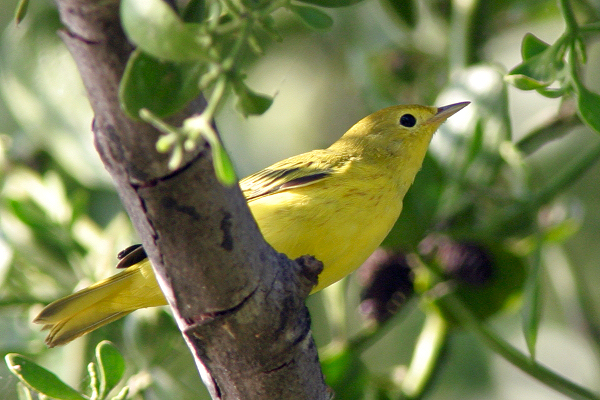
Date: 2005-08-07
Lens: Canon 300mm IS F4 + 1.4x II Converter

 Yellow Warbler
Dendroica petechia
Yellow Warbler
Dendroica petechia
 Description
Description
The Yellow Warbler is one of the most widespread of all warblers and show great geographical variation. There are more than 35 recognized subspecies that range from Canada to northern South America. The subspecies are divided into three main groups: Yellow Warbler proper (aestiva group), the Mangrove Warbler (erithachorides group), and the Golden Warbler (petechia group). Amoungst these groups there exist different races, some with different plumages.
Yellow Warblers often have their nest parasitized by Brown-headed Cowbirds, which lays its eggs in the nests of other birds. The warbler has developed a strategy to cope with unwanted eggs. If the cowbird eggs are discovered, the warbler will build a new nest layer, or floor, on top of the cowbird eggs. Two-story Yellow Warbler nests are not uncommon, and nests with as many as six stories have been found. Each layer containing one or more cowbird eggs. Evidence shows that nests built in swamps with a substantial Red-winged Blackbird population suffer less from cowbird parasitism, as the blackbirds exclude the cowbirds from the area.
General: 4.5 to 5 inches in length.
Adult Male: Yellow plumage. Greenish-yellow upperparts. Reddish or rust colored streaks on breast and flanks. Thin, dark pointed bill. Greenish-yellow wings and tail with yellow edges.
Female: Yellow plumage. Greenish-yellow upperparts. Lacks or has barely visible streaks on breast and flanks. Thin, dark pointed bill. Greenish-yellow wings and tail with yellow edges. Some southwester U.S. birds have a grayish wash to their plumage.
Immature: Similar to female.
Moist thickets, especially along streams and swampy areas.
 Nesting
Nesting4-5 pale blue eggs heavily spotted with brown. The eggs have a 11-12 day incubation period. Fledging occurs in 9-12 days. The nest is an open cup made from bark, plant fiber, and down. The female builds the nest and incubates the eggs. While on the nest, the female is fed by the male.